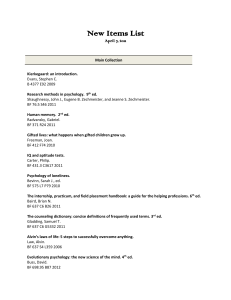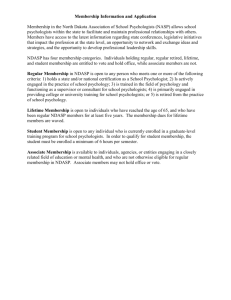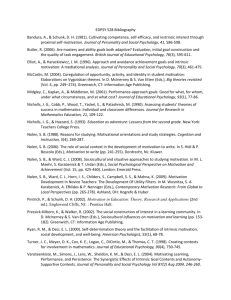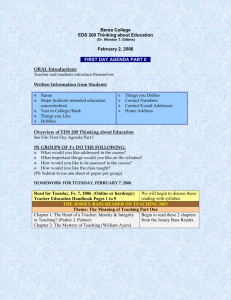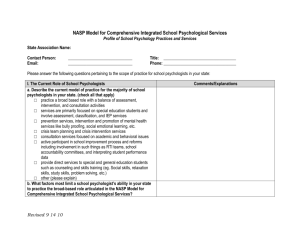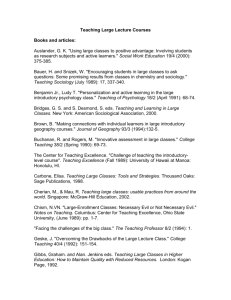MAXIMS - California State University, Sacramento
advertisement
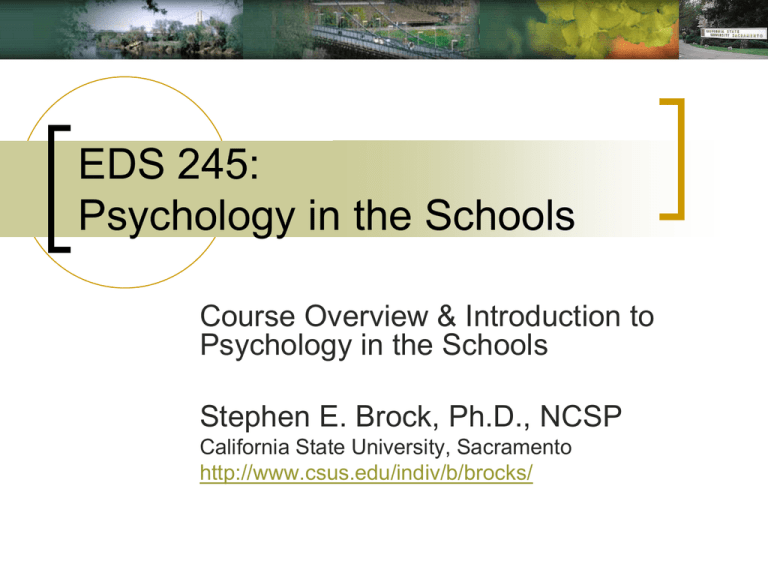
EDS 245: Psychology in the Schools Course Overview & Introduction to Psychology in the Schools Stephen E. Brock, Ph.D., NCSP California State University, Sacramento http://www.csus.edu/indiv/b/brocks/ Syllabus and Course Schedule Course Objectives Readings Hotsheets (divide into groups) Observations (find a mentor) Reflection Papers Grading Historical Foundations Origins of practice 1890 to 1920 Mental tests Societal forces Child labor Compulsory schooling Lightner Witmer (father of school psychology) Attend to children who resist ordinary efforts of the school room Historical Foundations Clinics and psycho-educational testing (1900-1930) Purpose to differentiate among children First training programs for school psychologists in 1920-1930 Emerging regulations in 1930-39 Organizational identity (1940-49) Journals, state associations Historical Foundations The First Conference May 5 and 6, 1950 Hotel Stockton 85 participants from 55 School Systems, and 8 Colleges 4 page program 1 “presentation” 3 “discussions” 4 “workshops” Historical Foundations California Association of School Psychologists (CASP) http://www.casponline.org Convention Oct. 15-17, 2015, Riverside, CA National Association of School Psychologists (NASP) http://www.nasponline.org Convention Feb. 10-13, 2016, New Orleans, LA Historical Foundations American Psychological Association (APA, Division 16) http://www.apa.org/about/division/div16.aspx Convention Aug 4-7, 2016, Denver, CO International School Psychology Association http://www.ispaweb.org/ Convention July 20-23, 2016, University of Amsterdam, Netherlands Historical Foundations Post war growth tied to developments in education Accepted nationwide Societal trends at end of 1960’s affected school psychology Historical Foundations 1970 to 1990’s expansion of role and special education PL 94-142, IDEA 1990’s questioning of traditional role Current societal forces At risk children Changes in special education Why Children Need School Psychologists Learning difficulties Behavior concerns Fears about war, violence, terrorism Problems at home or with peers Depression and other mental health issues Attention problems Poverty Diverse populations with diverse needs From NASP (2003) The School Psychologist’s Job Qualifications and Definition http://www.cde.ca.gov/ls/cg/pr/psychec.asp http://www.nasponline.org/resources/handouts/What %20is%20a%20School%20Psych.pdf Skills School Psychologists Need NASP Domains of Practice www.nasponline.org/about_nasp/domains.pdf California Commission on Teacher Credentialing Standards (CCTC) http://www.ctc.ca.gov/educator-prep/standards/pps.pdf The NASP Practice Model The 10 Domains of Practice Domain 1: Data-Based Decision Making and Accountability Domain 2: Consultation and Collaboration Domain 3: Interventions and Instructional Support to Develop Academic Skills Domain 4: Interventions and Mental Health Services to Develop Social and Life Skills Domain 5: School-Wide Practices to Promote Learning Domain 6: Preventive and Responsive Services Domain 7: Family–School Collaboration Services Domain 8: Diversity in Development and Learning Domain 9: Research and Program Evaluation Domain 10: Legal, Ethical, and Professional Practice NASP (2010) Assessment School psychologists work with children, parents and staff to help determine a child’s: Academic skills Learning aptitudes and styles Personality and emotional development Social skills and behavior issues Learning environments, school climate Special education eligibility From NASP (2003) Consultation Help teachers, parents, and administrators understand child development and learning Provide positive alternatives for helping children with learning and behavior problems Strengthen working relationships among educators, parents, and community services From NASP (2003) Prevention Implement programs to build positive connections between students and adults Identify potential learning difficulties early Design programs for children at risk Help adults to address problem behavior(s) Foster tolerance and appreciation of diversity Create safe, supportive learning environments From NASP (2003) Intervention Work face-to-face with children and families Develop individualized solutions for learning and adjustment Plan and implement crisis response Provide Counseling Social skills training Behavior management solutions From NASP (2003) Education Train teachers and parents in: Teaching and learning strategies Parenting techniques Classroom management techniques Working with exceptional students Strategies to address substance abuse and risky behaviors Crisis prevention and response From NASP (2003) Research & Program Development Recommend and implement evidencebased programs and strategies Generate new knowledge of learning and behavior Evaluate effectiveness of programs and interventions Contribute to school-wide reform and restructuring From NASP (2003) Mental Health Care Deliver school-linked mental health services Coordinate with community resources and health care providers Partner with parents and teachers to create healthy school environments From NASP (2003) Advocacy School Psychologists Encourage/Sponsor Appropriate education placements Education reform Legislative involvement Community services and programs Funding for adequate resources Adapted from NASP (2003) What Do School Psychologists Do? Assessment (EDS 245, EDS 248, 242A & B, 244 & 243, 247 & 243, EDS 240) Consultation (EDS 245, EDS 248, 240, 246A & B) Prevention (EDS 245, EDS 246A & B) Intervention (EDS 245,EDC 210, EDS 231, 248, 241 & 440, 240, 246A & B) Education (EDS 245, EDS 2240, EDS 246A & B) Research & program development (EDS 250) Mental health care (EDS 245, EDC 210, EDS 231, EDS 241) Advocacy (all) Adapted from NASP (2003) Who Are Today’s School Psychologists? Majority of are female (76.6%, up from 41% in 1969) and Caucasian (90.7%, down from 96% in 1980). Mean age of 47.4 (up from 38.8 in 1980). Employed in public schools (83.7). Training Level: Masters, 25.06%; Specialist, 45.76%; Doctoral, 24.17%. Majority (47.9%) have contracts lasting 170 to 190 days per year. A minority have contracts of 200 or more days (38.7%) Mean per diem salary is $356.49 per day. The current student to psychologist ratio is 1383:1 (down from 1482:1 in 2005). Castillo et al., (2011) Who Are Today’s School Psychologists? 56.2% receive administrative supervision. 75% participate in developing 504 plans Mean # of initial evals: 27.3 (down from 39.9 in 1999) Mean # of re-evals: 33.3 (down from 37 in 1999) 47% of work time is evaluations Consultations (mean #): individual, 39.3; group, 14.7; organizational/system, 8 Mean # of students counseled: 10.4 Mean # of In-service programs conducted: 3 Castillo et al., (2011) Ethnicity of School Psychologists Ethnicity White/Caucasian Hispanic/Latino Black/African-American Asian-American/Pacific Islander American Indian/Alaskan Native Other % 90.7 13.4 3 1.3 0.6 1 Source: 2003 NASP membership survey (69% response rate) Ethnicity Comparison U.S. Population School Psychologists From NASP (2003) Rules of School Psychology 1. Focus on student needs. 2. There is no such thing as bad data. 3. School psychologists make psycho-educational recommendations, tests don’t. Everything is data. 5. There are bad data interpretations. Use tests don’t let them use you. 4. Student needs dictate interventions, not simply what’s convenient for adults. There are many ways to understand a student and develop recommendations. Never draw a conclusion from a single data source. Look for multiple sources of agreement before coming to any conclusion. 28 Rules of School Psychology 6. Look for information that will guide interventions. 7. There is no such thing as an “un-testable” child. 8. This will make you uncomfortable, but you need to GET OVER IT!!!! You need to earn the right to share an expert opinion. 10. There are students for whom standardized tests are psychometrically invalid. You will need to ask difficult questions and deliver bad news. 9. Meaningful data provides guidance that leads to student success. Just because you are a “school psychologist” doesn’t mean you will be listened to. Always strive to give away psychology. Psycho-educational strategies are not a covert and should be understood by all. 29 Rules of School Psychology Be attentive to what students do well. 11. Assertively identify student strengths and use this information to guide interventions. Always tell students what to do. 12. Avoid simply telling students what not to do. Never think you have all the answers. 13. Always ask good questions and be a life-long learner. Be a critical consumer of psycho-educational tools & interventions. 14. Use empirically supported tools/interventions, but remain open to new approaches. 30 CSUS School Psychology Becoming a school psychologist at CSUS. Student Handbook School Psychology Program Handbook Department of Special Education, Rehabilitation, and School Psychology College of Education California State University, Sacramento September 2011 CSUS Program Goals Continually develop professional skills through reflective practice, critical thinking and mindfulness of current research. Understand the structure of schools and other agencies that serve students with special needs. Are cognizant of effective instructional practices and use this knowledge in fostering cognitive/academic development for all students. CSUS Program Goals Conceptualize student needs from a developmental and ecological perspective. Are cognizant of prevention and intervention strategies that foster positive mental, physical and academic well being for both students and staff. Utilize a wide range of methods in assessing student needs, designing appropriate interventions and evaluating the effectiveness of those interventions. CSUS Program Goals Engage in ongoing evaluation of programs and services with an awareness of organizational change strategies. Utilize counseling and consultation approaches that reframe problems with the goal of developing strategies for solution. Implement problem-solving approaches that lead to problem solution within the school framework or to an appropriate outside referral. CSUS Program Goals Develop an understanding of specialized needs of diverse student populations, including issues of culture, unique learning needs, alternative lifestyles etc. Collaborate with schools and parents in implementing interventions that promote positive outcomes for all students. Conduct themselves in a manner consistent with ethical and legal standards of the profession. Program Structure PPS School Psychology Credential requires: Coursework (less than 55 units if already have a Maters) Practica (EDS 242 [4 units], 243 [6 units] and 439 [4 units]) Praxis Exam (160 or higher; 165 is the NCSP standard) Internship (EDS 441,30 units, 1200 hours) M.A. requires: Coursework (55 units) Educational Research (EDS 250, 3 units) Praxis Exam (160 or higher) or Project (EDS 541) Case Study Exam (EDS 249, 3 units, 8 out of 10) Program Structure Education Specialist Degree Course work for the M.A. Education Specialist Seminar (EDS 239, 3 units) Culminating Experience (EDS 540 or 542, 3 to 6 units) Credentials/Licenses/Certification School Psychology Intern Credential For practice as an intern psychologist in schools Administered by California Commission on Teacher Credentialing (CCTC) PPS School Psychology credential For practice in schools Administered by CCTC Credentials/Licenses/Certification Licensed Educational Psychologist Licensed Professional Clinical Counselor Administered by Board of Behavioral Science Examiners Private practice in California Nationally Certified School Psychologist Administered by NASP Complete a NASP approved program (CSUS was re-approved in Fall 2011) Pass the Praxis exam (165+) What You Do to Get What You Need & When You Need It First Semester Certificate of Clearance Second Semester Advancement to Candidacy for Masters Course Equivalenciesform for M.A. Graduation Writing Assessment Requirement (GWAR) Fully classified (complete all prerequisites) What You Do to Get What You Need When You Need It Third Semester Reservation for EDS 249 Application for Graduation, M.A. Advancement to Candidacy, Ed.S. Fourth Semester Reservation for EDS 239, Ed.S. Seminar Case Study Masters Exam Praxis http://www.ets.org/praxis/nasp Internship Credential What You Do to Get What You Need When You Need It Fifth Semester Reservation for EDS 542 Ed.S. Seminar (EDS 239) Application for Graduation, Ed.S. All required forms for internship available at http://www.csus.edu/indiv/b/brocks/ Sixth Semester Ed.S. Thesis/Project PPS credential application Course Equivalency form different from Advancement to Candidacy Application for graduation Agreement & Contract Confidentiality Agreement Conduct Contract See also Appendix C of the University Catalog Questions? Next Week (9/9/15, Consultation) Read: • Best Practices in School Psychology: Data-Based and Collaborative Decision Making. William P. Erchul & Hannah L.Young, Chapter 29, Best Practices in School Consultation. • Best Practices in School Psychology: Data-Based and Collaborative Decision Making. Robin S. Codding, Lisa M. Hagermoser Sanetti, & Florence D. Digennaro Reed, Chapter 34, Best Practices in Facilitating Consultation and Collaboration with Teachers and Administrators.
